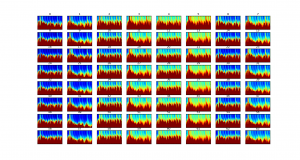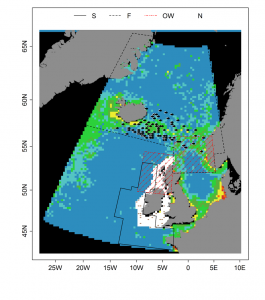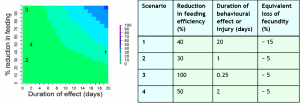Project: Exploring structural uncertainties in the marine biogeochemical model
PhD student: Prima Anugerahanti
Supervisors: Dr. Shovonlal Roy (GES), Prof. Keith Haines (Meteorology), Dr. Kevin White (GES)
Prima is interested in modelling marine phytoplankton and its uncertainties, especially in the model functional forms. She is also interested in probabilistic biogeochemical model predictions as it will be able to provide the means for policymakers and environmental agencies to determine the best actions in helping to mitigate anthropogenic and natural threats, such as ocean acidification, eutrophication, or harmful algal bloom.

The dynamics of biogeochemical models are determined by the mathematical equations used to describe the main biological processes. Earlier studies have shown that small changes in the model formulation may lead to major changes in system dynamics, a property known as structural sensitivity. During her PhD, Prima has explored how structural sensitivity affects the 1D biogeochemical model. In this project, she uses an ensemble approach in order to assess the effect of structural sensitivity, whereby each ensemble member contains tuned function parameterisations, describing key biogeochemical processes, such as nutrient uptake and zooplankton grazing.
Alongside statistical metrics, she also uses phytoplankton to quantify the impact of structural sensitivity. The spread of the ensemble as a measure of uncertainty is assessed against observations, both from the in-situ and satellite, using Normalised RMSE Ratio (NRR). The study found that small perturbations in the model formulation can produce large ensemble spreads, especially when perturbing plankton mortalities and grazing functions. This study has proved a novel way to generate a realistic ensemble of a biogeochemical model, which may be helpful for the probabilistic predictions. Currently she is working on the optimisation of the number of ensemble members before applying it to a global 3D model, in order to reduce the computational cost.
Project: Predicting fish population demographics and distribution using individual-based models
PhD student: Robin Boyd
Supervisors: Dr. Shovonlal Roy (GES), Prof. Richard Sibly (SBS), Dr. Kieran Hyder (Cefas), and Dr. Robert. B. Thrope (Cefas).
Rob is interested in understanding the mechanisms and processes that relate fish population dynamics and distribution to other components of the ecosystem. The knowledge of how various biological and abiotic drivers affect fish populations from disciplines such as behavioural and physiological ecology is currently available. However, some mechanisms, such as what determines the survival of fish eggs and larvae, remain elusive. The more we can understand about these processes, the better informed and more predictive our models can be.

Fish population demographics and distribution are affected by multiple ecosystem drivers, including food availability, temperature, and exploitation. Modelling the effects of these drivers requires the inclusion of features such as local interactions, variation among individuals and adaptive traits, which traditional population models cannot easily accommodate. During his PhD, Rob has worked with a team of supervisors at the University of Reading and CEFAS to develop an individual-based model (IBM) for marine fish populations that can incorporate these features. The model is forced by remotely-sensed estimates of food availability and temperature, and fishing mortality estimated from stock assessment. The ways in which the drivers affect the individuals in a population are modelled in detail, using basic principles of behavioural and physiological ecology. Rob and his team then study the emergent population dynamics using computer simulation. To demonstrate the use of the model they have calibrated and validated it using a case study of mackerel in North East Atlantic. Ongoing applications of the model include predicting how the mackerel population will respond to different management and climate change scenarios.
Project: Predicting the numbers and location of seabass for sustainable management
PhD student: Joseph Watson
Supervisors: Prof. Richard Sibly (SBS), Dr. Shovonlal Roy (GES), Dr. Kieran Hyder (Cefas), and Dr. Robert. B. Thrope (Cefas).
Joe’s interests are the sustainable management of fisheries to both preserve the marine ecosystem for biodiversity and as a vital food resource. He is interested in all aspects of fisheries management, including the biotic and abiotic components of the ocean as well as the socio-economics of the fisheries industry. Using a modelling approach provides a perfect tool to combine all aspects of fisheries management and create intelligent dynamic solutions for a sustainable ocean.

European sea bass (Dicentrarchus labrax) is an important recreational and commercial species, but stocks have been declining since 2010 due to a combination of overfishing and poor recruitment. Recreational fishing is currently restricted to catch and release under the assumption that returned fish are unaffected. The survival rate of caught and released fish has been well explored but little is known about the sub-lethal impacts of catch and release fishing. By modelling the energy budget we explore the sub-lethal impacts of catch and release fishing on bass growth and reproduction. Individual-based models (IBM) of fisheries, including sea bass, have been developed to test potential commercial fishery management approaches, but missing from these models is the behaviour of the fishermen. Decisions about when and where to fish effect total fishing pressure and where it is focused. Decisions may be influenced by both political and environmental scenarios. We aim to undertake a survey of fisherman to provide data on which to build an IBM of bass fisherman. We hope to investigate how political, economic and environmental changes affect bass fishing pressure. We hope that these studies will fill in gaps in fisheries modelling for bass and provide a basis for realistic investigation of contrasting strategies of sea bass management.
Project: Energy transfer in marine ecosystem based on phytoplankton size structure from satellite remote sensing
– to be added
Project: Algal growth and competition in a controlled environment
– to be added
Project: The changes in biomass density of zooplankton in the global ocean over the past 20 years; causes, consequences and future mitigation
– to be added
Project: Impacts of aerosol particulates in the East China Sea, The Yellow Sea and South East China on Oceanic biomass
– to be added
